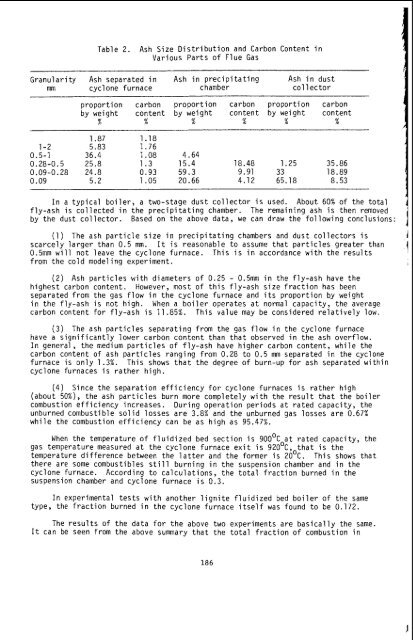the coking properties of coal at elevated pressures. - Argonne ...
the coking properties of coal at elevated pressures. - Argonne ...
the coking properties of coal at elevated pressures. - Argonne ...
Create successful ePaper yourself
Turn your PDF publications into a flip-book with our unique Google optimized e-Paper software.
Table 2. Ash Size Distribution and Carbon Content in<br />
Various Parts <strong>of</strong> Flue Gas<br />
_____<br />
Granularity Ash separ<strong>at</strong>ed in Ash in precipit<strong>at</strong>ing Ash in dust<br />
mm cyclone furnace chamber col 1 ector<br />
proportion carbon proportion carbon proportion carbon<br />
by weight content by weight content by weight content<br />
% % % % % %<br />
1.87 1.18<br />
1-2 5.83 1.76<br />
0.5-1 36.4 1.08 4.64<br />
0.28-0.5 25.8 1.3 15.4 18.48 1.25 35.86<br />
0.09-0.28 24.8 0.93 59.3 9.91 33 18.89<br />
0.09 5.2 1.05 20.66 4.12 65.18 8.53<br />
In a typical boiler, a two-stage dust collector is used. About 60% <strong>of</strong> <strong>the</strong> total<br />
fly-ash is collected in <strong>the</strong> precipit<strong>at</strong>ing chamber. The remaining ash is <strong>the</strong>n removed<br />
by <strong>the</strong> dust collector. Based on <strong>the</strong> above d<strong>at</strong>a, we can draw <strong>the</strong> following conclusions:<br />
(1) The ash particle size in precipit<strong>at</strong>ing chambers and dust collectors is<br />
scarcely larger than 0.5 mm. It is reasonable to assume th<strong>at</strong> particles gre<strong>at</strong>er than<br />
0.5mm will not leave <strong>the</strong> cyclone furnace. This is in accordance with <strong>the</strong> results<br />
from <strong>the</strong> cold modeling experiment.<br />
(2) Ash particles with diameters <strong>of</strong> 0.25 - 0.5mm in <strong>the</strong> fly-ash have <strong>the</strong><br />
highest carbon content. However, most <strong>of</strong> this fly-ash size fraction has been<br />
separ<strong>at</strong>ed from <strong>the</strong> gas flow in <strong>the</strong> cyclone furnace and its proportion by weight<br />
in <strong>the</strong> fly-ash is not high. When a boiler oper<strong>at</strong>es <strong>at</strong> normal capacity, <strong>the</strong> average<br />
carbon content for fly-ash is 11.85%. This value may be considered rel<strong>at</strong>ively low.<br />
(3) The ash particles separ<strong>at</strong>ing from <strong>the</strong> gas flow in <strong>the</strong> cyclone furnace<br />
have a significantly lower carbon content than th<strong>at</strong> observed in <strong>the</strong> ash overflow.<br />
In general, <strong>the</strong> medium particles <strong>of</strong> fly-ash have higher carbon content, while <strong>the</strong><br />
carbon content <strong>of</strong> ash particles ranging from 0.28 to 0.5 mm separ<strong>at</strong>ed in <strong>the</strong> cyclone<br />
furnace is only 1.3%. This shows th<strong>at</strong> <strong>the</strong> degree <strong>of</strong> burn-up for ash separ<strong>at</strong>ed within<br />
cyclone furnaces is ra<strong>the</strong>r high.<br />
(4) Since <strong>the</strong> separ<strong>at</strong>ion efficiency for cyclone furnaces is ra<strong>the</strong>r high<br />
(about 50%), <strong>the</strong> ash particles burn more completely with <strong>the</strong> result th<strong>at</strong> <strong>the</strong> boiler<br />
combustion efficiency increases. During oper<strong>at</strong>ion periods <strong>at</strong> r<strong>at</strong>ed capacity, <strong>the</strong><br />
unburned combustible solid losses are 3.8% and <strong>the</strong> unburned gas losses are 0.67%<br />
while <strong>the</strong> combustion efficiency can be as high as 95.47%.<br />
When <strong>the</strong> temper<strong>at</strong>ure <strong>of</strong> fluidized bed section is 900°C <strong>at</strong> r<strong>at</strong>ed capacity, <strong>the</strong><br />
gas temper<strong>at</strong>ure measured <strong>at</strong> <strong>the</strong> cyclone furnace exit is 92OoC, th<strong>at</strong> is <strong>the</strong><br />
temper<strong>at</strong>ure difference between <strong>the</strong> l<strong>at</strong>ter and <strong>the</strong> former is 2OoC. This shows th<strong>at</strong><br />
<strong>the</strong>re are some combustibles still burning in <strong>the</strong> suspension chamber and in <strong>the</strong><br />
cyclone furnace. According to calcul<strong>at</strong>ions, <strong>the</strong> total fraction burned in <strong>the</strong><br />
suspension chamber and cyclone furnace is 0.3.<br />
In experimental tests with ano<strong>the</strong>r lignite fluidized bed boiler <strong>of</strong> <strong>the</strong> same<br />
type, <strong>the</strong> fraction burned in <strong>the</strong> cyclone furnace itself was found to be 0.172.<br />
The results <strong>of</strong> <strong>the</strong> d<strong>at</strong>a for <strong>the</strong> above two experiments are basically <strong>the</strong> same.<br />
It can be seen from <strong>the</strong> above summary th<strong>at</strong> <strong>the</strong> total fraction <strong>of</strong> combustion in<br />
186

















